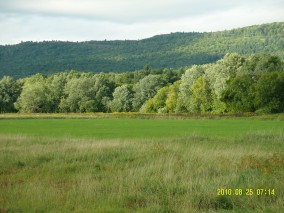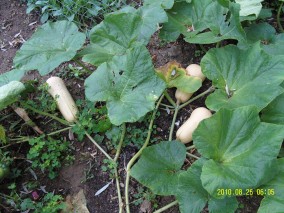Earth’s Response to human stresses on the natural landscape
- Article Published At:
- Rutland Herald
- Date of Publication:
- August 29th, 2010
The summer here in Pittsford has been really enjoyable, with plenty of rain and sunshine and, for the first summer in years, almost no mosquitoes in our garden. This year we have an extraordinary crop of summer and winter squash, and plenty of tomatoes and basil. I have been mixing weeds and leaves with the waste food from the Rutland Food Coop for years, and this has given us an abundant supply of compost. Improving soil fertility takes time but is symbolic of the need to give back more to the Earth than we take from it, if we are to create a resilient, sustainable world.
Globally the supply of phosphorus is dwindling. Phosphorus is an intrinsic part of our DNA. We add phosphorus-rich fertilizers to increase world food production, but much washes off into rivers and lakes, where it feeds excessive growth of weeds and algae and removes dissolved oxygen. When animal manure is applied directly to fields, rain also washes off some phosphorus that pollutes streams. Phosphorus is generally not recovered from human waste water treatment, so a “peak phosphorus” crisis is approaching.
Like the peak oil crisis, it is double-edged. We have a growing population dependent on finite resources — phosphorus and food, oil and energy — and growing waste problems affecting the natural environment, including fresh water pollution and atmospheric greenhouse gas pollution. Yet in both cases, we are afraid to invest in non-polluting sustainable solutions, because they are costly and require structural changes in society.
Back in Washington as election season approaches, our Congress still seems lost and blind. Another year has passed, and our government has failed to pass a bill to regulate greenhouse gas emissions and develop a sustainable energy policy — despite the growing challenge of finding enough oil and the disaster in the Gulf. Instead our military expenditure approaches a trillion dollars and is one of the largest components of the federal budget. This will not solve any of the real threats we face: climate, fresh water, energy and the global food supply. We need to move from a military economy to a productive and sustainable economy.
The U.S. Constitution gave no rights to the Earth, and the Earth has no vote in our elections. But in one generation, the response of the Earth to our foolish, short-sighted behavior is going to transform our world and our politics. It is time for us as citizens to take stock and see if we can collectively build an alternative vision.
What can a scientist do? I decided this summer to set up a Web site (https://alanbetts.com) to archive my research, my public talks and these columns. I have also been working on local climate change indicators for Vermont, to get a picture of what has been happening to the state’s climate and ecosystems during the past few decades. This helps us connect global climate change to our local experience of the weather and the seasons. It also gives us a rough guide to likely trends in Vermont over the next few decades.
We need this information because we will have to adapt to the climate change that is coming. As rainfall intensity increases with warming temperatures, we must plan for increased runoff. We must manage our human stresses on the natural landscape, as it will be hard for Vermont’s forests and wildlife to adapt to a rapidly changing climate.
The days are getting shorter, and fall is only a few weeks away. I hope that what you planted in spring has brought you a full harvest.
Peak Phosphorus: http://www.foreignpolicy.com/articles/2010/04/20/peak_phosphorus
Related Topics
Figures and Images
 Figure 1: Forest in late summeracross valley
Figure 1: Forest in late summeracross valley Figure 2: Butternut squashGood crop in 2010
Figure 2: Butternut squashGood crop in 2010